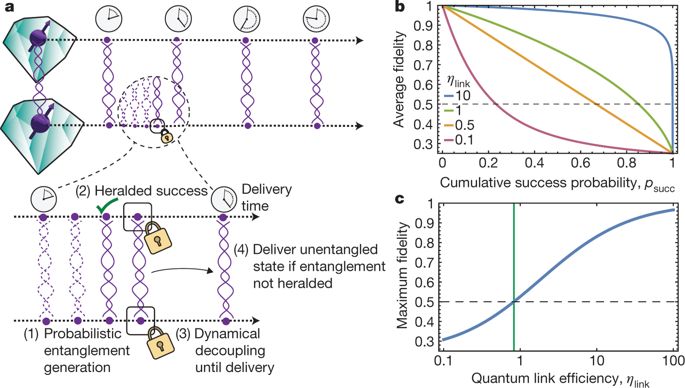Our official English website, www.x-mol.net, welcomes your feedback! (Note: you will need to create a separate account there.)
Deterministic delivery of remote entanglement on a quantum network
Nature ( IF 64.8 ) Pub Date : 2018-06-01 , DOI: 10.1038/s41586-018-0200-5 Peter C. Humphreys , Norbert Kalb , Jaco P. J. Morits , Raymond N. Schouten , Raymond F. L. Vermeulen , Daniel J. Twitchen , Matthew Markham , Ronald Hanson
Nature ( IF 64.8 ) Pub Date : 2018-06-01 , DOI: 10.1038/s41586-018-0200-5 Peter C. Humphreys , Norbert Kalb , Jaco P. J. Morits , Raymond N. Schouten , Raymond F. L. Vermeulen , Daniel J. Twitchen , Matthew Markham , Ronald Hanson

|
Large-scale quantum networks promise to enable secure communication, distributed quantum computing, enhanced sensing and fundamental tests of quantum mechanics through the distribution of entanglement across nodes1–7. Moving beyond current two-node networks8–13 requires the rate of entanglement generation between nodes to exceed the decoherence (loss) rate of the entanglement. If this criterion is met, intrinsically probabilistic entangling protocols can be used to provide deterministic remote entanglement at pre-specified times. Here we demonstrate this using diamond spin qubit nodes separated by two metres. We realize a fully heralded single-photon entanglement protocol that achieves entangling rates of up to 39 hertz, three orders of magnitude higher than previously demonstrated two-photon protocols on this platform14. At the same time, we suppress the decoherence rate of remote-entangled states to five hertz through dynamical decoupling. By combining these results with efficient charge-state control and mitigation of spectral diffusion, we deterministically deliver a fresh remote state with an average entanglement fidelity of more than 0.5 at every clock cycle of about 100 milliseconds without any pre- or post-selection. These results demonstrate a key building block for extended quantum networks and open the door to entanglement distribution across multiple remote nodes.Remote deterministic spin–spin entanglement is achieved using nitrogen–vacancy centres in diamonds and a single-photon entangling protocol, with much improved entangling rates compared to previously used two-photon protocols.
中文翻译:

量子网络上远程纠缠的确定性传递
大规模量子网络有望通过节点之间的纠缠分布实现安全通信、分布式量子计算、增强的传感和量子力学的基本测试1-7。超越当前的双节点网络 8-13 需要节点之间产生纠缠的速率超过纠缠的退相干(丢失)速率。如果满足此标准,则可以使用固有概率纠缠协议在预先指定的时间提供确定性远程纠缠。在这里,我们使用相距两米的菱形自旋量子比特节点来演示这一点。我们实现了一个完全预示的单光子纠缠协议,该协议实现了高达 39 赫兹的纠缠率,比之前在该平台上演示的双光子协议高三个数量级。同时,我们通过动态去耦将远程纠缠态的退相干率抑制到 5 赫兹。通过将这些结果与有效的电荷状态控制和光谱扩散的缓解相结合,我们确定性地提供了一个新的远程状态,在大约 100 毫秒的每个时钟周期内平均纠缠保真度超过 0.5,无需任何预选或后选。这些结果证明了扩展量子网络的关键构建块,并为跨多个远程节点的纠缠分布打开了大门。 使用钻石中的氮空位中心和单光子纠缠协议实现了远程确定性自旋-自旋纠缠,大大改善了纠缠率与以前使用的双光子协议相比。
更新日期:2018-06-01
中文翻译:

量子网络上远程纠缠的确定性传递
大规模量子网络有望通过节点之间的纠缠分布实现安全通信、分布式量子计算、增强的传感和量子力学的基本测试1-7。超越当前的双节点网络 8-13 需要节点之间产生纠缠的速率超过纠缠的退相干(丢失)速率。如果满足此标准,则可以使用固有概率纠缠协议在预先指定的时间提供确定性远程纠缠。在这里,我们使用相距两米的菱形自旋量子比特节点来演示这一点。我们实现了一个完全预示的单光子纠缠协议,该协议实现了高达 39 赫兹的纠缠率,比之前在该平台上演示的双光子协议高三个数量级。同时,我们通过动态去耦将远程纠缠态的退相干率抑制到 5 赫兹。通过将这些结果与有效的电荷状态控制和光谱扩散的缓解相结合,我们确定性地提供了一个新的远程状态,在大约 100 毫秒的每个时钟周期内平均纠缠保真度超过 0.5,无需任何预选或后选。这些结果证明了扩展量子网络的关键构建块,并为跨多个远程节点的纠缠分布打开了大门。 使用钻石中的氮空位中心和单光子纠缠协议实现了远程确定性自旋-自旋纠缠,大大改善了纠缠率与以前使用的双光子协议相比。



























 京公网安备 11010802027423号
京公网安备 11010802027423号